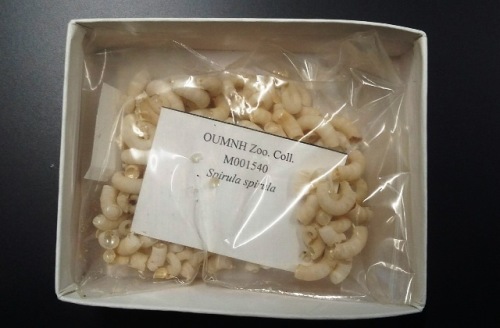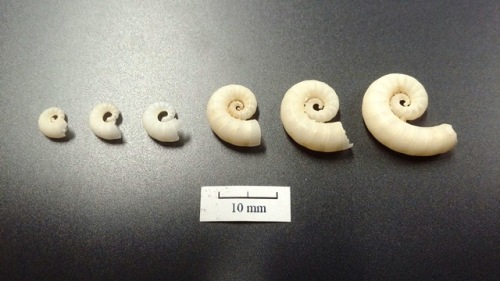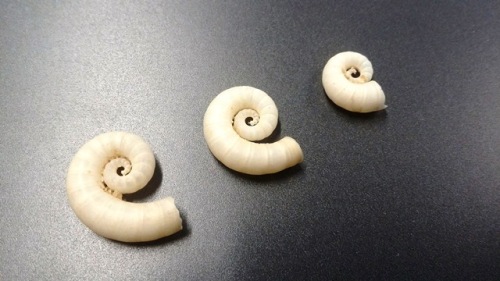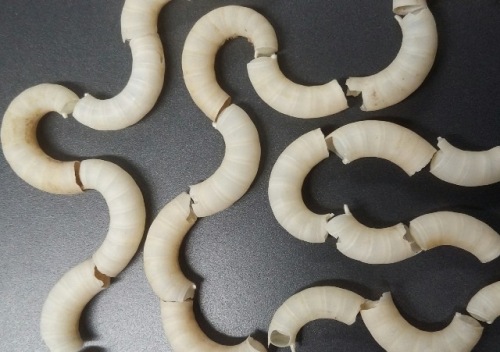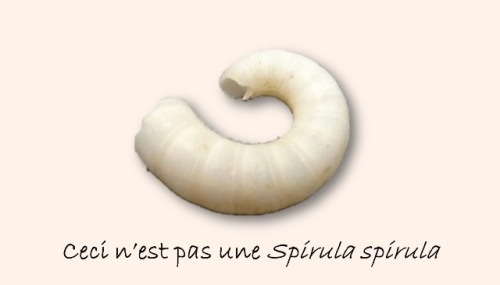Digitisation in museums remains a hot trend. On paper, all we need to do is digitise specimens, stick ’em online et voila, everyone in the world has access to our beautiful specimens. Of course, it isn’t quite as straight forward as this but I won’t go over the issues with esoteric resource finding, digitisation vs visualisation and access to the Internet here, instead I’m going to focus on the difficulties of visualising natural history specimens. Unlike prints and paintings, most natural history specimens don’t really have an obvious ‘side’ to take an image of. Flat fossils, herbarium sheets and microscope slides are a bit more obvious but then it all falls apart when it comes to disarticulated skeletons, fluid preserved specimens, taxidermy, nests and even eggs.
This blog post is a guide to taking images of one particular kind of specimen relatively common in natural history museums, the shells of the curious ram’s horn squid, Spirula spirula. So-called because their internal shells are shaped like ram’s horns, the shells of this widespread marine species are found washed up on shorelines across the globe. It is the only living species in the order Spirulida. Little is known about the specifics of where these animals live, how they reproduce, feed and migrate but the shells of these specimens are common in museum collections. Here are the 12 contemporary ways you can visualise these characteristic shells.
First of all, let me introduce you to our model for this post, OUMNH.ZC.M001540 from the Oxford University Museum of Natural History which is 150+ S.spirula shells and broken shell chambers in addition to countless fragments. It’s impossible to say exactly how many individuals we have here as a number of partial shells could belong to the same individual. There are lots of natural history specimens like this, lots of different individuals stored together. But how do you image them in a way that makes sense?
Ronseal Style
Named after the woodstain and wood-dye manufacturer after their popular advertising slogan from the 1990s “It does exactly what it says on the tin”. This is an image of the specimen as you would find it in the stores. No raz. No matazz. Not especially useful for seeing the individual specimens but it gives you an idea of what to expect and on the upside is extremely easy to capture an image like this.
Picture Perfect Style
Although Ronseal style does what it says on the tin, it’s a bit messy. Picture perfect style dictates that you pick out one or two of the nicer looking specimens and use it as a representative of the whole. Sure, it doesn’t really capture the whole specimen. This style loved by marketing and press types for magazine covers, website images etc.
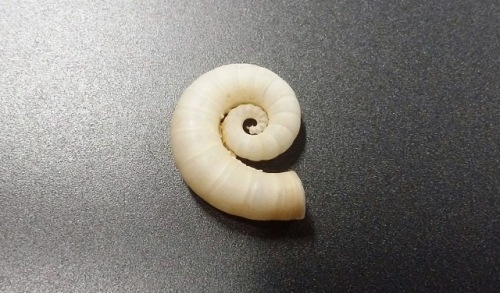
OUMNH.ZC.M001540 Spirula spirula Picture Perfect style (c) Oxford University Museum of Natural History
Picture Perfect With a Lab Coat and Glasses Style
Picture perfect does the job if you’re looking for style but, it’s pretty useless scientifically. How big is this specimen? What does it look like from other angles? That’s where PPwLCaG Style comes in. It’s still a nice(ish) picture with a bit more information related to it. Loved by publishing scientists, hated by marketing and image library types. Time consuming and fiddly depending on the specimen and may require image stacking and digital scale bars which just don’t seem to come as standard with most imaging software. This image I took hastily, ideally the camera should be parallel to the imaging plain and not at a slight angle as this messes up the usefulness of the scale bar and taking digital measurements. Probably the most common style used by museums ranging from professionally executed to shaky-cam, out of focus mobile snaps (as in this instance).

OUMNH.ZC.M001540 Spirula spirula Picture Perfect With a Lab Coat and Glasses Style showing left and right views with all important scale (c) Oxford University Museum of Natural History
Spice of Life Style
Specimens like this are the reason why natural history museums have such large collections, for example the specimens in this box equates to roughly 1% of the National Portrait Gallery’s collections (excluding the reference collections). We’re not just interested in one of every species but how species vary over time and space. Spice of Life style can be used to show the variety of specimens. This image here is a mix of PPwLCaG and Spice of Life style just showing a range of the nicest looking shells in this lot. As you can see there are big and small shells which we wouldn’t have got from a single shell image. WARNING: Size may depend on preservation, so originally large shells missing the last chambers will look much smaller. It pays to be familiar with the group you’re looking at and the signs of maturation. In Ram’s horn squid, adult males are slightly smaller than females.
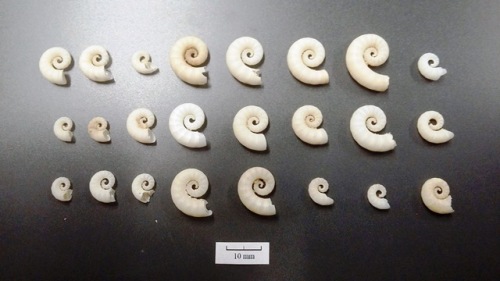
OUMNH.ZC.M001540 Spirula spirula Spice of Life Style (c) Oxford University Museum of Natural History
Progression of Spirula Style
Named after the widely used and regularly parodied ‘porgression of man’ illustrations, this is a spin on Spice of Life style but satisfyingly arranged in size order. Convenient for small sample sizes but increasingly problematic for larger lot sizes without creating extremely wide or long images. The same caveats as double checking size against preservation from the section above.
Word Cloud Style
Word clouds are great in that they look like they say something interesting but actually don’t really. The same principle applies for word cloud style when it comes to visualising Spirula shells. Considered by some to be a variant of Ronseal style, with the added advantage that at least most of the individual specimens can be seen. Easy to capture images like these but do build in some clearing up time, especially if you’ve got lots of fragments.
Flying Ducks Style
You too can create that 1970’s household kitsch aesthetic in your own mollusc collections database! Heavily relies on having at least three differently sized specimens.
Macaroni Art Style
Preferred style for those who don’t have children but want a reminder of how hideous macaroni pictures are as an art form and just generally as things. Takes the tiniest sliver of creativity and a bit of time to ‘arrange’. The downside to this style is it could be confused with actual macaroni pictures in social history collections for multidisciplinary museum services so make sure your metadata is clear.
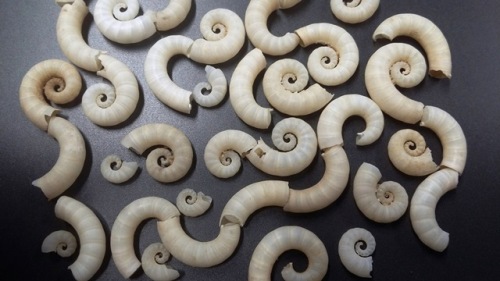
OUMNH.ZC.M001540 Spirula spirula Macaroni Art Style. Ugh. (c) Oxford University Museum of Natural History
Regency Style
For those who have even less taste, regency (sometimes called late Georgian) style can make your online mollusc collections invoke memories of trudging around an historic house on a rainy Sunday and spending £34 on a pot of tea and a muffin. Quite reliant on some steady hand skills and appropriate proportions of shells with the protoconch attached and broken end chambers.

OUMNH.ZC.M001540 Spirula spirula Regency Style. Most of them are 20th Century reconstructions anyway. (c) Oxford University Museum of Natural History
Pipemania Style
This newish style is popular with the generation that comes before Millenials but after the ‘Fuck about not really doing much’ generation, whatever that’s called. Inspired by Late 1980s early 1990s videogame Pipemania. This style is strangely addictive but omits specimens with a protoconch, which are arguably more interesting and useful.
Magritte Style
Popular in continental Europe, this style is perfect for partial specimens. Useful style for debates around the philosophy of conciousness and perception. Less useful for use in scientific papers. Important to record all the meta messages in your meta data.
Brady Bunch Style
Another great way to show the diversity of 9 specimens in a three by three grid. Purists leave the central square blacked out. Several spin off styles and two awful 1990s film versions.
These are the 12 most popular styles in contemporary use for taking images of Spirula spirula specimens and I’ve excluded some fringe styles for brevity. Due to the lack of current standards in imaging Spirula spirula shells, hopefully this blog post will help to shape current standards in the discipline or at least result in some conformity across online databases and other digital resources.

